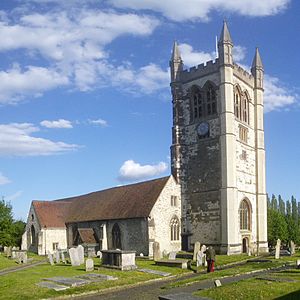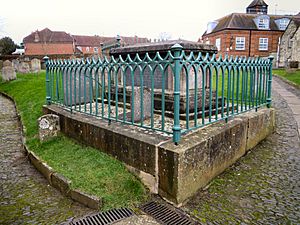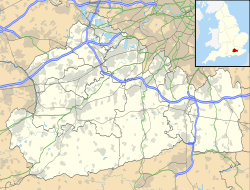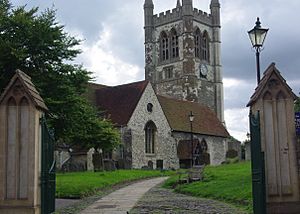St Andrew's Church, Farnham facts for kids
Quick facts for kids St Andrew's Church, Farnham |
|
|---|---|

The church from the northwest
|
|
| 51°12′48″N 0°48′03″W / 51.2132°N 0.8007°W | |
| OS grid reference | SU 83866 46680 |
| Location | Farnham, Surrey |
| Country | England |
| Denomination | Anglican |
| Website | StAndrewsFarnham.org |
| History | |
| Status | Parish church |
| Dedication | Saint Andrew |
| Consecrated | 1399 |
| Architecture | |
| Functional status | Active |
| Heritage designation | Grade I |
| Designated | 5 March 2015 |
| Administration | |
| Deanery | Farnham |
| Archdeaconry | Surrey |
| Diocese | Guildford |
| Province | Canterbury |
St Andrew's Church is an Anglican parish church located in the center of Farnham, Surrey, England. It is a very old and important building, with some parts dating back to the Middle Ages. Because of its historical value, it is a "Grade I listed building," which means it's protected and recognized as a significant part of England's heritage. The church is part of the Diocese of Guildford. In its churchyard, you can find the grave of William Cobbett, a famous political writer, and a memorial to Augustus Toplady, who wrote the well-known hymn 'Rock of Ages'.
Contents
History of St Andrew's Church

Early Beginnings: Saxon Times
In 2005 and 2006, during a special project to preserve and develop the church, workers found something amazing. They uncovered the foundations of a much older church from the 7th century, which was the Saxon period. We don't have any written records about this very first church. The oldest written mention of a church in Farnham is in the Domesday Book from 1086. This book, which was like a big survey of England, said that the area of Farnham was owned by the Bishop of Winchester. It also mentioned that the church there was "richly endowed," meaning it had a lot of money and resources.
Building the Medieval Church
The oldest parts of the current church building were constructed between 1150 and 1170. Around this time, a new church area called the Archdeaconry of Surrey was created. The new archdeacon, a church official, used Farnham and its castle as a main place to visit other churches in Surrey.
In 1399, important work on the chancel (the part of the church near the altar) and the east end of the church was completed. The large window at the east end of the church still looks the same as it did back then. On June 22, 1399, the bishop officially dedicated the church.
Changes Over the Centuries
On February 16, 1487, the local church community received permission from King Henry VII to hire a special priest called a curate. Also, a small chapel, known as a chantry chapel, was built on the north side of the church. This chapel was dedicated to the Virgin Mary.
In the early 1500s, a new tower was added to the west end of the church. It was quite small, only a few meters taller than the main roof. Later, during the time of King Henry VIII, chantry chapels were closed down. The chapel at St Andrew's was turned into a school room. In 1758, it was sold and taken down to help pay for repairs to the church.
Victorian Restoration and Growth
The 1800s were a time of big changes and improvements for the church. Much of this work happened thanks to John Utterton, who was an important church leader in Surrey. In 1836, gas lighting was put into the church, making it much brighter.
Starting in 1855, a major restoration project began. The main seating areas were updated, old galleries (balconies for seating) were removed, and the side sections of the church were made larger. In 1865, the church tower was made much taller, reaching its current height of about 35 meters (115 feet). In 1879, James Conway Brown became the church's organist.
20th Century Updates and Modern Times
More changes were made to the church in the 1900s. In 1909, the south chapel was restored and renamed the Lady Chapel. A big restoration project took place in 1956, led by architect David Nye. During this time, the altar was moved to a more central spot, and the organ and choir seating were also moved.
From 1990 to 2005, people worked hard to raise money and plan a large project. This project aimed to strengthen and repair the church's structure and foundations. They raised £1.3 million, and Ptolemy Dean was the architect for this important work. The tower and clock were repaired, the supporting walls were rebuilt, and the old Victorian pews were replaced with chairs.
Key Features of the Church
The Baptismal Font
In the south part of the church, you can see a beautiful baptismal font from the 1400s. A font is a basin used for baptisms. This one is carved with special symbols and monograms that represent the four evangelists (Matthew, Mark, Luke, and John). It was moved to its current spot in 1959. A family named Barlow gave it to the church in the 1830s, but how they got it is a mystery!
The East Window
The stone frame of the east window has not changed since the Middle Ages. However, the colorful glass you see today was put in during the 1800s. It was designed by a famous architect named Augustus Pugin and made by Hardman & Co. in 1851. The window shows detailed scenes from the life of Jesus.
Important Graves and Memorials
Outside the main entrance of the church, you will find the grave of William Cobbett (1763–1835). He was a political writer and reformer who was born, baptized, and grew up in Farnham. There is also a special memorial to him on the church's tower wall.
Inside the church, at the back, there is a copy of the "Vinegar Bible" on display. This Bible has a famous printing mistake where "vineyard" was spelled "vinegar." It was given to the church in 1731 by Arthur Onslow. You can also find a plaque dedicated to Augustus Toplady, who wrote the famous hymn 'Rock of Ages'. He was born in Farnham and baptized in this very church in 1740.
St Andrew's Church in the Community
Church and School Connection
Right next to St Andrew's Church is St Andrew's Primary School. The church and school have a very close relationship. It's a church-controlled school, and sometimes classes from the school visit the church for special worship services.
Services and Activities
The church is open every day for visitors. Morning and evening prayers are held on Mondays, Tuesdays, and Thursdays. On Sundays, there are communion services at 8 AM and 10 AM, with evening prayer at 6 PM.
Because the church uses chairs instead of fixed pews, it's a very flexible space. This allows the church to host many different events, such as concerts, plays, art exhibitions, school events, parties, and public meetings. The church also has groups that work to promote Fairtrade products and support campaigns like Make Poverty History, which aims to reduce poverty around the world.
In 2022, St Andrew's Church was used as a filming location for the BBC One television mini-series Inside Man. The actor David Tennant played a character who was a reverend in the series, filmed right here in the church.
Gallery
-
William Cobbett's grave
-
View of the church from Farnham Castle
See also












